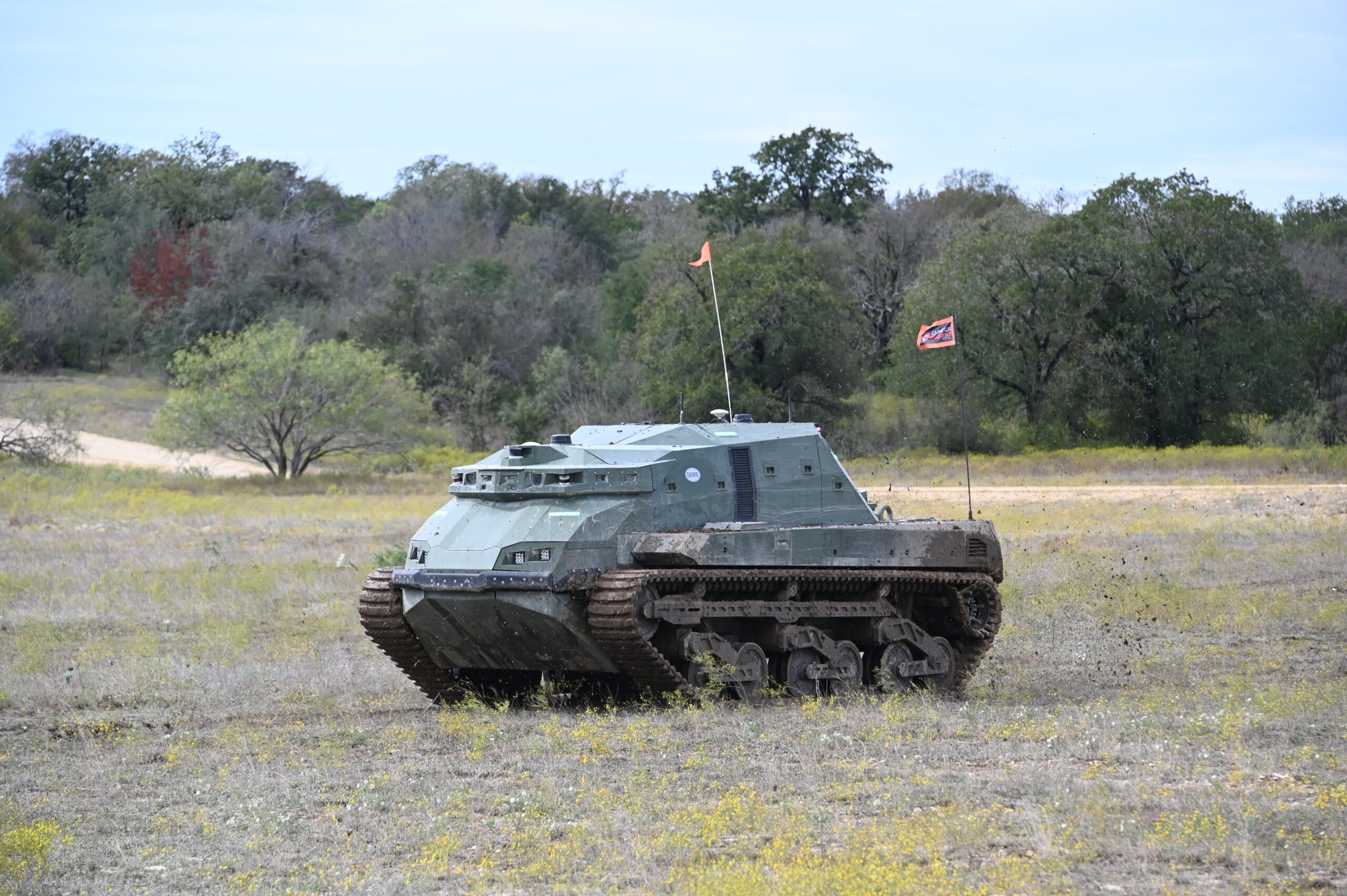The US Defense Advanced Research Projects Agency’s (DARPA’s) Robotic Autonomy in Complex Environments with Resiliency (RACER) programme has successfully tested autonomous movement on a new, much larger fleet vehicle, the agency announced on 23 April 2024.
The test – a significant step in scaling up the adaptability and capability of the underlying RACER algorithms – involved RACER Heavy Platform (RHP) vehicles: 12-ton, 6 m-long, skid-steer tracked vehicles that similar in size to forthcoming robotic and optionally manned US armoured fighting vehicles.
RHPs utilise the Textron M5 base platform previously developed and used in US Army campaigns of learning for robotic combat vehicle requirements and acquisition and are upfitted and supported for RACER autonomy integration hardware stacks and software by Carnegie Robotics.
The RHPs complement the 2-ton, 3.36 m-long, Ackermann-steered, wheeled RACER Fleet Vehicles (RFVs) already in use.
“Having two radically different types of vehicles helps us advance towards RACER’s goal of platform agnostic autonomy in complex, mission-relevant off-road environments that are significantly more unpredictable than on-road conditions,” Stuart Young, RACER programme manager, was quoted as saying in a DARPA press release. “For Phase 2, adding the combat-scale RHP robot supports porting and performance demonstration of RACER autonomy stacks at multiple scales concurrently while moving between highly varied terrains.”
RACER’s second phase began last autumn with its fourth experiment (E4), which included the first testing of RHPs and testing on RFVs by teams from the University of Washington and from NASA’s Jet Propulsion Laboratory. RACER is on pace to continue its autonomy development and experiment spirals with a new round of development and testing roughly every six months.
“Our Phase 2 off-road average autonomous speed goals are higher at lower intervention rates, and both RFVs plus now RHPs allow RACER to also show adaptability and resiliency of autonomous software at multiple, platform-agnostic ground robot scales in an array of complex, military-relevant environments,” said Young. “As we also add tactics-based autonomy, we see all of these together as vitally important to army and marine needs in robotic vehicle programs of record that are closely tracking RACER, and which represent possible transition opportunities for the program.”
RACER E4 took place in late 2023 at military training areas in Texas. Using fully unoccupied RFVs, RACER demonstrated autonomous movement within a 15-square-mile terrain area that included highly diverse ground vegetation cover, trees, bushes, rocks, slopes, obstructed ditches and creek crossings. Adaptability was further demonstrated by successful runs at night with equivalent performance results. The two RACER teams had not previously operated in, nor been exposed to, sensor data sets of the E4 military training areas and were given no practice upon arrival before starting official courses, presenting an opportunity for autonomy stacks to be adaptively improved – but only onsite and within the time offered during the experiment. Teams successfully completed over 30 autonomous runs on courses varying from three to 10 miles in length, achieving over 150 autonomous, unoccupied miles at speeds up to 30 mph (48 km/h).
Additionally, the RACER programme commissioned the RHP at E4 by operating for over 48 km in an autonomous route-following mode over similarly complex terrain to test low-level autonomous control, collect sensor data sets, assess mobility and refine operations. Finally, E4 began software development of RACER global planning with tactics and performed focus groups with uniformed subject matter experts stationed at the E4 military base to assist with defining input of tactical reasoning.
“RACER’s early Phase 2 activities, both with Experiment 4 performance successes in difficult, new-to-the-programme, military relevant terrain in Texas, as well as recent incorporation of RHP as a fleet platform, is setting the tone for the programme to achieve tougher autonomous manoeuvre goals while showing autonomy resiliency and adaptability to new environments on any robot at any scale,” said Young.
The fall 2023 RACER E4 followed Phase 1 experiments in March 2023 in (Fort Irwin, California), September 2022 (Camp Roberts, California) and March 2022 (Fort Irwin, California). RACER is planning two experiments in 2024 to keep its every-six-month cadence of field tests to keep robots constantly improving; in between, the two RACER Phase 2 teams will continue constant development and testing at multiple test sites local to each.







